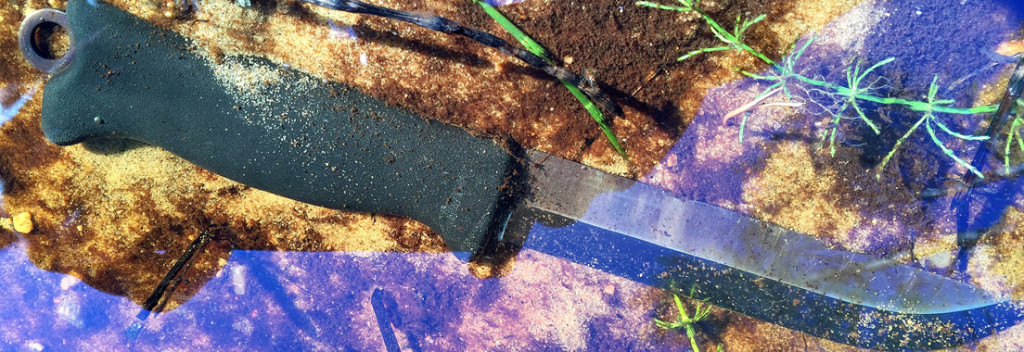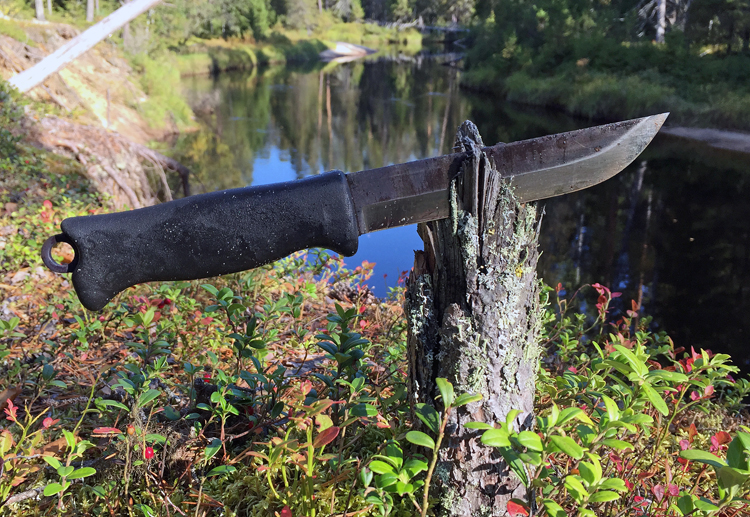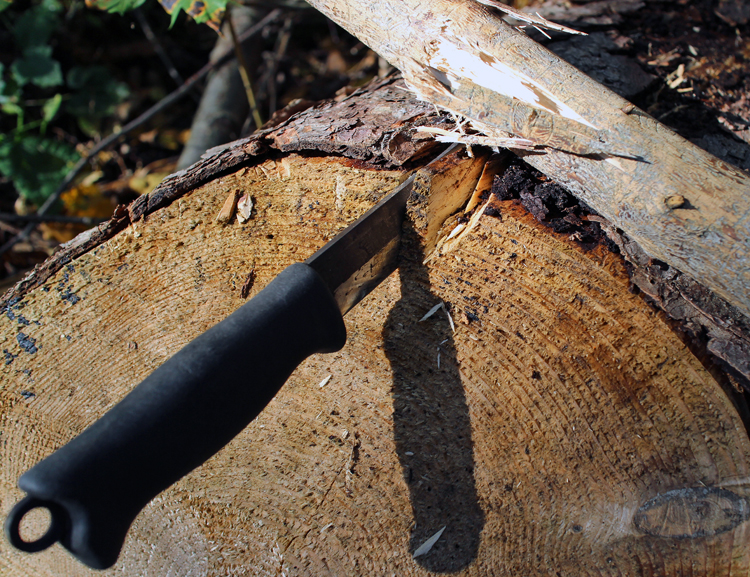The superb ergonomics and the practical design of Varusteleka’s Skrama-knife left us waiting for the company to make a smaller knife with the same design philosophy. During the summer of 2015 Varusteleka released some sneak peek photos on Instagram of just that knife. It appeared to have similar handle contour as the Skrama, but the blade seemed to be straight off a traditional puukko-knife. During the fall of the same year they released the new knife, or actually two versions of a new knife: ”The Terävä Jääkäripuukko 110” and ”The Terävä Jääkäripuukko 140”. The number at the end of the model name refers to the length of the blade in millimeters. The Finnish model name “Jääkäripuukko” roughly translates into “Jaeger Knife” in English.
The measurements and materials:
- Blade length: 110/140 mm, width 26 mm, thickness: 4 mm
- Primary bevel angle: 23°
- Total length: 240/270 mm
- Steel: Carbon steel 80CRV2, hardness 59 HRC
- Handle: Cast rubber with a non slip surface texture
- Weight (Without the sheath): 175/195 g
The knives are 100% made in Finland. The blades are made by Laurin Metalli and the sheaths by R. Kauppila. Both companies are based Kauhava, a town that has deep roots in the Finnish knife culture. We received samples of both knives at the time they were released.
When you pick the Jääkäripuukko up the first time, you’ll notice immediately that it’s made to be used. It has the same utilitarian design as the Skrama-knife.
The handle
The rubber handle feels good in the hand. It’s thinner than on most knives this size making it easy to feel which way you’re holding the knife even in the dark. The thin handle also makes it easy to carry it inside for example a Hill People Gear Kit Bag (The 110 model). The fit of the handle to the user is a highly personal thing, but it would be safe to say that it probably fits most users well. The fairly low profile finger guard is not in the way of whittling or other woodworking. The slight curve on the other end of the handle makes it easy to remove the knife from the sheath and offers a solid grip at the very end of the handle while chopping. The tang is a hybrid between a stick tang and a full tang. The tang protrudes trough the end of the handle forming a large lanyard loop.
The blade
The shape of the blade is straight off of a traditional puukko. The spine runs straight all the way to the tip. On the sharpened side the straight part of the edge is maximized and the belly of the blade starts to curve only five sentimeters before the tip. This helps to make the tip strong. It also makes the blade easy to whittle with and to sharpen. The blade is 4 millimeters thick. The edge has a 23 degree primary bevel. In addition there is a steeper secondary bevel to make the blade more durable. The secondary bevel is something that might create friction among the hard core puukko fans. It makes the knife a little harder to sharpen in the field, but we were positively surprised how little it affected the whittling capability of the knife. It was super easy to make perfect fuzzy sticks and the blade still stood up to a lot of abuse.
The spine of the blade has not been rounded making it a pleasure to strike sparks out of a ferro rod. The flat sides of the blade have not been polished adding to the utilitarian style of the knife.
The sheath
The sheath is made out of leather that is two millimeters thick. The quality of the leatherwork is nice for a knife in this price range. The side seam is reinforced with rivets on both ends. The rivet at the end has a hole in it for attaching a cord. There is a sturdy plastic insert inside the leather. There is a hole at the end of the sheath and the plastic insert to drain any water out. The sheath retains the knife by a large snap on the seam side of the opening. The snap had a tendency to open if the end of the sheath was twisted hard enough. The knife is still retained by the sheath even if the snap is open, so it’s not a deal breaker. The belt loop is a Scandi-style dangler with a heavy duty D-ring between the loop and the sheath.
Testing
This article is based on 19 days of testing that included a five-day hunting trip. All of the other testing was conducted in a backyard environment. We will continue to use the knives, but we wanted to get this article out to you as soon as possible since it’s a new product on the market.
We decided to subject the model 140 to the more demanding tests and use the 110 like we would normally use a knife. We chose the longer knife for the harder testing because it’s more likely to end up being used as a chopping tool. On the other hand we figured the shorter blade should stand up to anything the longer one would. Although this wasn’t a torture test where you bend knives in a wise until they break, the model 140 was abused in a way that is in no way considered normal use for a knife. We tried to keep all of the testing as realistic as possible.
Cutting and whittling
We started the testing with simple everyday tasks. We opened packages, cooked and made fires. As mentioned previously, whittling was a pleasure with both of the knives. The fairly thin grind makes cutting a variety of materials effortless. The thick blade is not optimal for making thin slices while preparing food, but peeling an apple is doable. We used the model 140 on the sandiest pieces of wood we found lying on the ground. It was also poked in the dirt in between tasks.
Chopping
We did some chopping with both of the knives. Obviously the longer bladed model 140 worked better for that. With a two finger grip at the very end of the handle you can get a lot more power in to the strikes. Attaching a lanyard at the end of the knife would be a big help in chopping. Since we were testing the knives, we didn’t modify the knives in any way. With the 140 we could chop thru wrist thick branches with ease. The 140 was also used to dig and chop underground roots of fatwood tree stumps. We were able to create a small ding to the blade in this phase of the test.
Batoning
Both knives were used to baton through different sized pieces of wood without issues. With the model 140 we used rocks as the ”baton”. This left some marks on the spine of the blade, but did not affect the usability of the knife in any way.
Throwing sparks off of a ferro rod
The 90 degree spines on the knives were used to throw sparks from a ferro rod to make fire. It was easy to create powerful showers of sparks with both knives. The spines of the blades come handy in other scraping tasks as well.
A knife as an ice pick
It’s advisable to carry ice picks with you if you move on frozen lakes or rivers. The emergency ice picks can be substituted with a knife in an emergency. During the time of the testing we had no ice to walk on, so we used the 140 to assist us in climbing up a steep riverbank. The knife was struck tip first in to the bank and used as a handhold. This didn’t affect the functioning of the knife. We anticipated the blade to get really dull after all of the sand testing, but all of the testers were surprised to see how well the edge retained its sharpness.
Submerging
We sank the 140 in a river with and without the sheath to test the drain holes on the sheath and the rust resistance of the blade steel. The water drained out of the sheath nicely. We left the knife in it’s sheath without any kind of drying what so ever. 24 hours later we removed the knife from the sheath to assess the damage. There were only a few couple millimeter wide rust spots on the bevel. Carbon steel is commonly referred as a material that rusts easily, so we were positively surprised about the results. Dragging the knife in the sandy bottom of the river made the snap of the sheath considerably stiffer to operate. Rinsing it with water made it work better, but some lubrication would probably restore the snap to its original condition. It took two days for the leather sheath to dry out completely.
The dishwasher
No one is stupid enough to put their carbon steel knife in the dishwasher. Right? Well, someone that’s not into knives at all might do it so we decided to run the 140 through the dishwasher. We selected the 45-60 Celsius degree wash program and fired up the washer. After the wash there was a lot of rust spots and stripes on the blade.
After both the water and the dishwasher tests we used the knife normally to see if the knifes performance had degraded. Even after the dishwasher the knife worked just fine. We cleaned the blade with rapeseed oil and managed to get the rust out, but there were some black pitting marks we couldn’t remove.
Sharpening
After the above-mentioned testing the blade had started to get dull on the 140. It would still cut a variety of materials and you could whittle with it, but more force was required.
We tested how hard it would be to restore sharpness of the blade by sharpening it with a “Spyderco Sharpmaker” – sharpener. Restoring factory sharpness took about 15 minutes. It seemed really effortless compared to some of the more modern steels we’ve used, which was anticipated. The heat treatment of the blade seems to be just right. Good sharpness, good edge retention and ease of sharpening is not common in a knife especially at this price point.
Driving the blade into a log
The previous test had very little effect on the usability of the knives. That’s why we decided to test the limits of the 140 by driving it into a log tip first. This would prove the durability of the lanyard loop at the end of the handle. We used a tree branch about a meter long to beat it in. We drove the blade about half way into the log. Some of the strikes hit the end of the rubber handle material. We removed the knife by beating the handle sideways back and forth with the branch. We repeated this two more times. On the third time we noticed the handle had moved about three millimeters towards the layard loop. Needless to say this is far beyond normal use of a knife. If there would be a need to drive a blade into a log it could be removed much more gently than we did. We decided to remove the handle off the blade so we could observe the tang inside. In a knife like this you should be able to create a usable handle in the wilderness should the original handle break. The tang would facilitate this easily by wrapping something around it.
Although we managed to separate the handle from the blade, the handle remained intact. We could slip the handle back on and use the knife. Just by reinserting the handle there was some play between it and the blade. Once we got all the photos of the tang, we glued the handle back on with some epoxy glue. This removed all of the play from the handle and restored the knife back to normal.
Conclusion
These knives would serve nicely as the only knife of a casual hiker or as a part of a more elaborate set of tools for the seasoned woodsman. If you’re looking for a utilitarian knife with a Scandinavian flavor this is the knife for you. The 110 model in particular seems to have the perfect combination of durability, usability and compact form factor. When you combine this with the price (59,99 €), it’s a pretty good deal. The only thing we wanted the knives to have is a Kydex sheath option that would allow one handed operation and be easily mountable to a variety of outdoor gear. This is being taken care of, since Varusteleka is planning on introducing a Kydex sheath option for the knives.
The knives were given to us for testing by Varusteleka





